That Bloated Beast Under Brooklyn Bridge
Posted by: Loren Coleman on July 27th, 2012
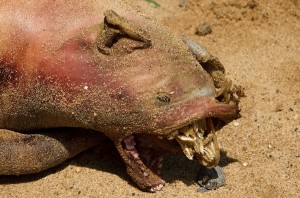
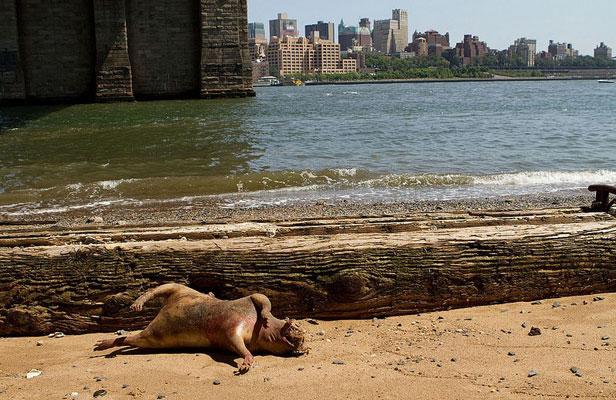
I was trying to avoid it, but the media ran me down for a comment.
If you ignore certain stories, I was hoping, they might go away. This one about yet another dead carcass find would not, and hasn’t. I even started seeing it show up in the French press.
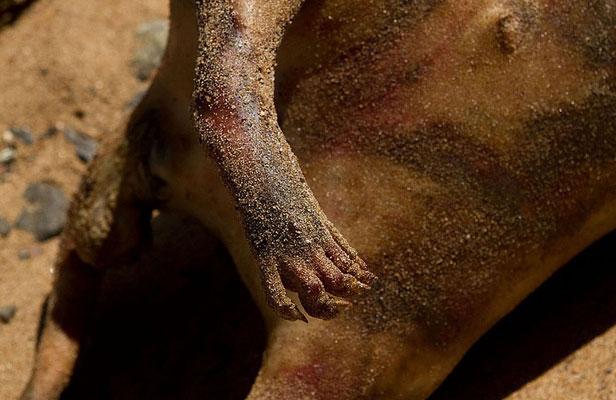
So I said okay to a media interview about it.
My comments were published overnight, here: “Brooklyn Bridge ‘Monster’ May Be Distant Relative Of Long Island Montauk ‘Monster’,” written by Lee Speigel, in Huffington Post.
I remain dismayed by this being the media’s “cryptozoology” highpoint of this summer. Let me share my quotes from this article, (which you can read entirely here).
Of course, the Montauk Monster was brought up:

Lee Speigel writes:
That animal, seen [above], was first dubbed the Montauk Monster by Loren Coleman, director of the International Cryptozoology Museum in Portland, Maine.
“Ever since 2008, when I investigated the media madness over the stranded, decomposing unknown ‘thing’ found on the beach at Montauk, unfortunately, every dead animal body, every carcass, has taken on fantastic creature importance,” Coleman told The Huffington Post in an email.
“But all have been found to be dead raccoons, dogs, swine, seals, dolphins, and even in one case, a dead sloth,” he said.
***
“There is nothing mysterious here, I would wage, and this one looks like a dead rat or dog, but we’d need to see the skull and more detailed photos to determine the species,” said Coleman, who writes on many animal mysteries, folklore and cryptozoology.
***
“From everything I am seeing and reading about, this appears to be a near match to the earlier Montauk Monster, which was a decomposed raccoon,” he said.“This one has raccoon digits which remind people of human fingers, raccoon teeth, plantigrade feet and also a bit of brown-grey fur on the tip of its tail — all dead (no pun intended) giveaways for a raccoon.”
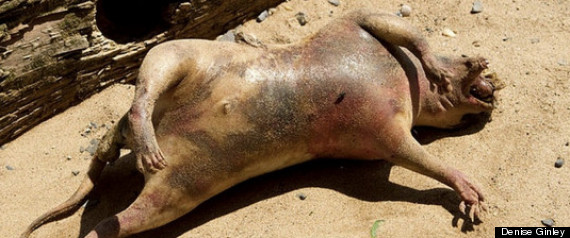
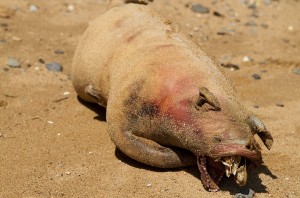
Is part of the bloated beast the media!!??
About Loren Coleman
Loren Coleman is one of the world’s leading cryptozoologists, some say “the” leading living cryptozoologist. Certainly, he is acknowledged as the current living American researcher and writer who has most popularized cryptozoology in the late 20th and early 21st centuries.
Starting his fieldwork and investigations in 1960, after traveling and trekking extensively in pursuit of cryptozoological mysteries, Coleman began writing to share his experiences in 1969. An honorary member of Ivan T. Sanderson’s Society for the Investigation of the Unexplained in the 1970s, Coleman has been bestowed with similar honorary memberships of the North Idaho College Cryptozoology Club in 1983, and in subsequent years, that of the British Columbia Scientific Cryptozoology Club, CryptoSafari International, and other international organizations. He was also a Life Member and Benefactor of the International Society of Cryptozoology (now-defunct).
Loren Coleman’s daily blog, as a member of the Cryptomundo Team, served as an ongoing avenue of communication for the ever-growing body of cryptozoo news from 2005 through 2013. He returned as an infrequent contributor beginning Halloween week of 2015.
Coleman is the founder in 2003, and current director of the International Cryptozoology Museum in Portland, Maine.










Good work Loren.
This is another case of a quite common animal’s carcass which becomes something of a sensation…
Like always if one tries to identify such a carcass, it’s important to look on all available anatomical data (as well as the geographical location of course), because many people just look at the superficial look to make their decision. Many people thought this particular carcass was a pig, dog, a rat or some other kind of rodent. It’s all wrong. I will try to show what this animal was and what it was not.
Let’s start with the pig. That’s a big problem with unusual carcasses and unusual animals. Many people look only on superficial traits like pink hairless skin in this case. That’s enough for many to conclude this is a pig. A quick look at the feet shows this animal had finger-like paws on the front and long pawed feet at the back, so it´s obviously no ungulate of any kind.
Many people suggested it’s a squirrel, a rat or a nutria. Luckily there is a good photo which shows the dentition very well:
This is obviously no the dentition of any kind of rodent. Rodents have long incisors and a typical toothless space. Take a look at this nutria skull to see how a typical rodent skull looks:
http://de.wikipedia.org/w/index.php?title=Datei%3ANutriasch%C3%A4del.jpg&filetimestamp=20051006064136
This clearly rules out any kind of rodent as well. One of the most often suggested animals was a dog, and that’s surely closer than the already mentioned species. But it’s also no dog. Again the teeth are the best thing you can use for anatomical comparisons. Take again a look at the dentition of the carcass, it has small molars and a big premolars, all of equal size and comparably broad. Now look at a dog´s dentition:
Dogs have highly enlarged first molars in the mandible, and together with the last premolars in the upper jaw, this carnassial teeth work to cut meat. You can see the big size, laterally compressed shape and shearing areas on this teeth:
So the dentition also rules out a dog as well. But there are some other traits on the carcass you can see. If a normally hairy animal lose its fur, it can look quite different, as the fur often conceals the real shape of the body. To get a comparison it´s often good to look at taxidermy polyurethane forms, which are used as inner body for hides. So you can see a comparably stocky body, its hind legs are longer than the front legs, and the tail is quite thick on the base. This fits very well with the body shape of a raccoon:
There are also some other anatomical traits which are important. If you look at the hind legs, you can see they are plantigrade, i.e. the animal used its whole foot to walk (like ourselves or bears, and -surprise surprise – raccooons), unlike dogs which walk only on the tips of their feet. You can also see the paws. The toes are long and finger like, and there are five of them. This is also exactly like those of raccoons:
In contrast the toes of dogs are shorter and thicker, and there are only four of them as well as a small dewclaw:
To take again a look at the dentition of the carcass, please take the time to look at the number and shape of the teeth:
And now compare their number and shape to those of raccoons:
http://fc09.deviantart.net/fs4/i/2004/228/c/4/Raccoon_Skull__Side_View_2.jpg
http://courses.washington.edu/vertebra/452/photos/mammals/raccoon_skull_ventral.jpg
Raccoons are highly omnivorous and consume only very little meat, for this reason they have no big carnassial teeth, but broad and comparably small molars and a similarly shape 4th premolar.
The snout of the carcass is missing, and the lower canines seems to be broken, possibly the animal was roadkilled. But the data from the molars and premolars is anyway much more important. Looking at all data from this carcass, it is next to sure this was nothing but another dead raccoon. I am quite sure other people (who have probably not read what I have written because they are too lazy…) will again make comments and say it’s yet a dog or something else.
Sadly there is no real size comparison, but looking at the wooden beam at one of the photos, which doesn’t seem to be much thicker than around a half metre or so, I don’t think the whole animal was very big, and surely within the size range of raccoons.
I agree with the raccoon assessment.
These raccoons and oppossum really need to stop getting washed up after dying.
Loren,
While I understand your frustration, I think this was good exercise. Keeping in mind the old adage “there’s no such thing as bad press,” I think events like this can only help Cryptozoology. When confronted with an unknown, you applied science and reason, and came up with the right answer. A raccoon. If and when something washes up in Loch Ness, or a large furry body is found in the Cascades, people are more likely to accept the possibility of the unknown, having listened to a professional in Cryptozoology like yourself solve the “mystery” of strange looking but known species. Great work.